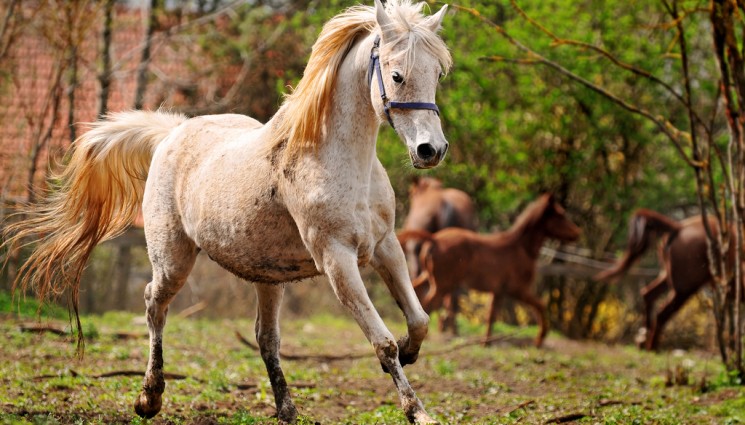The Arabian or Arab horse (Arabic: الحصان العربي [ ħisˤaːn ʕarabiː], DMG ḥiṣān ʿarabī) is a breed of horse that originated on the Arabian Peninsula. With a distinctive head shape and high tail carriage, the Arabian is one of the most easily recognizable horse breeds in the world. It is also one of the oldest breeds, with archaeological evidence of horses that resemble modern Arabians dating back 4,500 years.
The Arabian developed in a desert climate and was prized by the nomadic Bedouin people, often being brought inside the family tent for shelter and protection from theft. Selective breeding for traits including an ability to form a cooperative relationship with humans created a horse breed that is good-natured, quick to learn, and willing to please. The Arabian also developed the high spirit and alertness needed in a horse used for raiding and war. This combination of willingness and sensitivity requires modern Arabian horse owners to handle their horses with competence and respect.
The Arabian is a versatile breed. Arabians dominate the discipline of endurance riding, and compete today in many other fields of equestrian activity. They are one of the top ten most popular horse breeds in the world. They are now found worldwide, including the United States and Canada, the United Kingdom, Australia, continental Europe, South America (especially Brazil), and its land of origin, the Middle East.
Size
The breed standard stated by the United States Equestrian Federation, describes Arabians as standing between 14.1 to 15.1 hands (57 to 61 inches, 145 to 155 cm) tall, “with the occasional individual over or under.”[3] Thus, all Arabians, regardless of height, are classified as “horses”, even though 14.2 hands (58 inches, 147 cm) is the traditional cutoff height between a horse and a pony.[14] A common myth is that Arabians are not strong because they are relatively small and refined. However, the Arabian horse is noted for a greater density of bone than other breeds, short cannons, sound feet, and a broad, short back,[2] all of which give the breed physical strength comparable to many taller animals.[15] Thus, even a smaller Arabian can carry a heavy rider. For tasks where the sheer weight of the horse matters, such as farm work done by a draft horse,[16] any lighter-weight horse is at a disadvantage.[16] However, for most purposes, the Arabian is a strong and hardy light horse breed able to carry any type of rider in most equestrian pursuits.[15]
Temperament
A dark horse moving towards the camera with head held high and legs striding forward.
Arabians are noted for both intelligence and a spirited disposition
For centuries, Arabian horses lived in the desert in close association with humans.[17] For shelter and protection from theft, prized war mares were sometimes kept in their owner’s tent, close to children and everyday family life.[18] Only horses with a naturally good disposition were allowed to reproduce, with the result that Arabians today have a good temperament that, among other examples, makes them one of the few breeds where the United States Equestrian Federation rules allow children to exhibit stallions in nearly all show ring classes, including those limited to riders under 18.[19]
On the other hand, the Arabian is also classified as a “hot-blooded” breed, a category that includes other refined, spirited horses bred for speed, such as the Akhal-Teke, the Barb and the Thoroughbred. Like other hot-bloods, Arabians’ sensitivity and intelligence enable quick learning and greater communication with their riders; however, their intelligence also allows them to learn bad habits as quickly as good ones,[20] and they do not tolerate inept or abusive training practices.[21] Some sources claim that it is more difficult to train a “hot-blooded” horse.[22] Though most Arabians have a natural tendency to cooperate with humans, when treated badly, like any horse, they can become excessively nervous or anxious, but seldom become vicious unless seriously spoiled or subjected to extreme abuse.[21] At the other end of the spectrum, romantic myths are sometimes told about Arabian horses that give them near-divine characteristics.[23]
Credits: Photo











Marvellous capture my firend. A real beauty in mid flight……stunning.
Thank you Natalie, I truly appreciate it! 🙂
fgfgfdg
Very beautiful and a superb action capture. The colours, light and details are stunning 🙂
You really caught the motion of this beauty! Flowing mane and tail are perfect!
Integer ante arcu, accumsan a, consectetuer eget, posuere ut, mauris. Praesent adipiscing. Phasellus ullamcorper ipsum rutrum nunc. Nunc nonummy metus.
The Arabian is a versatile breed.
This captures wonderful motion! Love the flowing mane and tail…
TEST
THIS IS A TEST FOR THE NEW TEMPLATE
wonderful theme but is it supported for arabic ?
i mean rtl in css ?
dgfgfdg
jjjjjjhjh
this is a test
great theme !
I am genuinely thankful to the owner of this web site who has shared this enormous post at at this place.
Your posting is ablstuoely on the point!
очень красивый сайт!